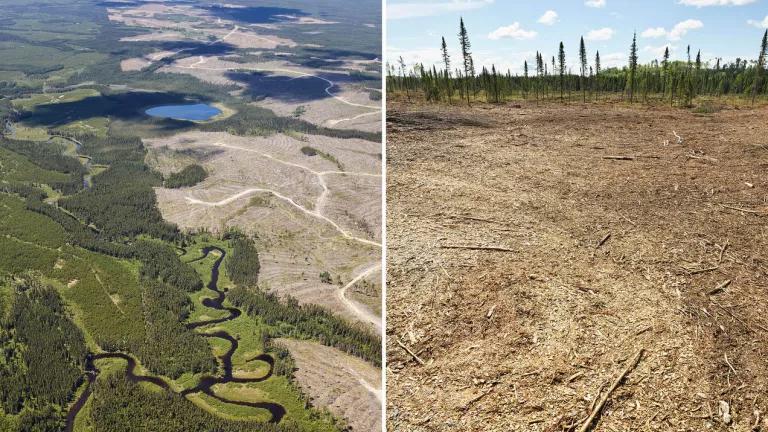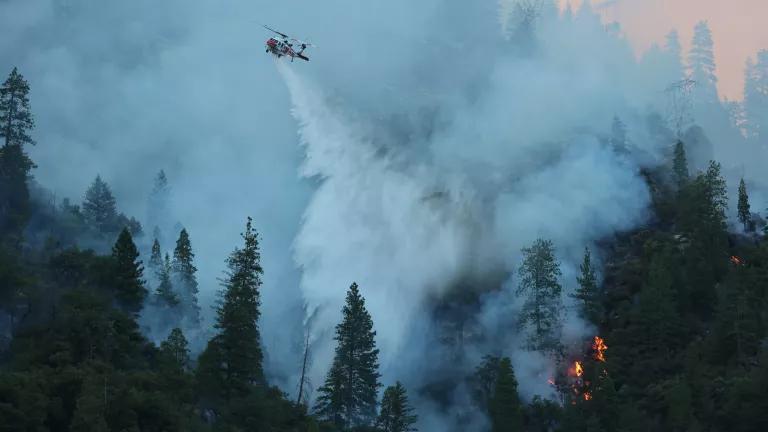Congress's Roadmap to Protect Wildlife on Endangered Species Day
This Endangered Species Day, let’s commit to do what science tells us we must do to protect these vital links in our shared ecosystems and prevent a stampede toward extinction.

Loggerhead turtle populations were listed for protection under the ESA because of serious threats like nesting-habitat loss from coastal development. But these newly hatched loggerhead turtles made their way safely to the sea in Florida.
Blair Witherington/Florida Fish and Wildlife Conservation Commission
When you work for an organization like NRDC, every day can feel like Endangered Species Day, fighting for the survival of our wildlife. Each year on the third Friday in May, we celebrate the success stories for plants and animals protected by the Endangered Species Act (ESA), our most effective law to conserve and recover our most vulnerable species.
Endangered Species Day marks more than just a celebration, though. It’s also a global day of action. Even as we recognize species that have been brought back from the brink of extinction, like the bald eagle and California condor, the future for our wildlife isn’t guaranteed.
Our planet and its creatures are in crisis. The climate and biodiversity crises are already having severe impacts on the natural world—we’re seeing more extreme weather and a million species are at risk of extinction, many within decades.
In February, the Intergovernmental Panel on Climate Change (IPCC) released a report urging world leaders to protect and restore more of our natural spaces to stave off disaster. President Joe Biden has pledged to tackle this challenge; the administration’s “America the Beautiful” initiative aims to reverse the nature crisis by conserving 30 percent of our nation’s lands, oceans, and inland waters by 2030.
Conserving wildlife is a key piece of the solution. Some of our most iconic species play critical roles in maintaining ecosystems, the natural environment, and our human existence. Their decline will have devastating consequences for our quality of life. Luckily, Congress has the opportunity to advance major protections for these creatures. This Endangered Species Day, here’s how Congress can help create more wildlife conservation success stories:
Increase pollinator-friendly practices
Pollinators, including birds, bats, butterflies, and bees, are vital for helping to put food on the table. These small but mighty species are essential for nearly $50 billion worth of crops produced in the United States each year, and support food sources for other wildlife, but their populations have seen dramatic declines due to harmful pesticides and a changing climate that disrupts their habitat.
A prime example of just how bad things are for bees is evident with the rusty patched bumblebee. These bees were finally listed under the ESA in 2017 after the U.S. Fish & Wildlife Service estimated they could go extinct within 30 years. To date, the rusty patched bumblebee is the only bee listed under the ESA, even as the larger bee crisis continues.

The once-common rusty patched bumble bee is at grave risk of extinction.
Kim Mitchell/USFWS
Late last year, Congress delivered what should have been a big win when the Bipartisan Infrastructure Law included provisions from the Monarch and Pollinator Highway Act that authorize grant programs for states and tribes to carry out pollinator-friendly practices on roadsides and help to cut down on harmful invasive plants. Except Congress never actually included the money to fund those programs.
In addition to issuing this critical funding, Congress can also pass other legislation that will help reverse these disturbing downward trends for threatened pollinators. The Saving America’s Pollinators Act will cut down the use of toxic pesticides, such as neonicotinoids, that are decimating bee populations, and increase transparency for networks that monitor the health of pollinator populations. Similarly, the MONARCH Act will boost funding for conservation projects to protect Western populations for the iconic monarch butterfly.
Create space for people and wildlife to thrive together
Reversing the biodiversity crisis will require a transformation in the human-wildlife relationship, including a shift from a mentality of conflict and competition to one of reciprocity and coexistence. Through the annual budget process, Congress can help mitigate human-wildlife conflict while preserving valued keystone species like wolves and beavers—with outsize benefits for all.

NPS
Beavers play a critical role in creating and preserving complex, resilient wetlands and river-scapes. This, in turn, helps to mitigate climate impacts like wildfire and drought, replenish dry floodplains, provide habitat for other wildlife, and create ideal environments for soils to sequester atmospheric carbon dioxide. Alarmingly, despite these widespread benefits, tens of thousands of beavers are killed each year to prevent them from disrupting agricultural fields, roadways, and properties. Nonlethal tools like fencing to protect valuable trees and water flow control devices to prevent flooding damage will help beavers remain on the landscape alongside humans without conflict, while also creating homes and refuge for an array of other plant and animal species.

Gray wolf at Necedah National Wildlife Refuge
Mary Jane Bean/USFWS
Top predators like wolves also help to share whole ecosystems because of their cascading influence on the food chain, from regulating prey populations to shifting plant communities and soils. In February, a U.S. federal court delivered a big win for gray wolves when it ruled to reinstate protections for them under the ESA, which were stripped by the Trump administration. However, gray wolf populations in the Northern Rockies are not covered by this recent ruling because Congress removed them from the ESA in 2011. Unless the federal government acts to restore those protections, Northern Rockies wolves will continue to face increased threats in states like Idaho, Montana, and Wyoming, where policies allow wolf bounties, the use of inhumane tools, and in some cases, unlimited killing, including wolf pups and pregnant wolves. Wolves are also often persecuted because they occasionally interact with or prey on livestock. Nonlethal techniques for proactively preventing these types of conflicts—such as fladry fencing, livestock guardian dogs, and range riders—can protect livestock and keep wolves out of trouble across the West and Great Lakes landscapes.
USDA Wildlife Services’ nonlethal initiative is leading the pack on how we respond to conflicts with wildlife by leveraging federal funding across 13 states to hire specialists dedicated to resolving human-wildlife conflicts using nonlethal strategies. These tools are proving increasingly valuable as Wildlife Services scales up its implementation, education, and outreach, and research, specific to nonlethal wildlife conflict prevention. First funded in fiscal year (FY) 2020, Congress can continue to provide Wildlife Services with another year of the federal funding needed to support and expand proactive conflict prevention efforts, in collaboration with landowners and agricultural communities who are living alongside wolves, beavers, bears, and other wildlife.
Eliminate harmful anti-science policy riders

Two male greater sage-grouse near Seedskadee National Wildlife Refuge
NPS
Sound environmental protection policy should be grounded in science. Such is, unfortunately, not the case for the greater sage grouse. An imperiled western bird, the sage grouse is an indicator species for the vast sagebrush sea wildlands that range from New Mexico to Montana and for the 300 other species of wildlife, including mule deer, pronghorn antelope, and golden eagles who call it home. Sage grouses and their habitat have been under threat for decades from livestock grazing, invasive grasses like cheatgrass, wind energy development, and the oil and gas industry.
Although the conservation community came together with states, ranchers, private landowners, and public officials in 2015 to protect the sage grouse through collaborative and comprehensive federal land use conservation plans, just the year before, Congress passed its annual funding bill with a policy rider that prevents the U.S. Fish & Wildlife Service from considering the greater sage grouse for future ESA protection. That means that if, and likely when, these birds and their habitat need federal protection to survive, they aren’t even eligible to get it.
During the Trump administration, the sage grouse saw one attack after another, with expanded oil and gas leasing on their habitat and rollbacks of critical habitat protections. Even as the Biden administration reconsiders the 2015 plans, a recent report from the U.S. Geological Survey highlights that sage grouse populations have dwindled by 80 percent in the last 50 years and nearly 40 percent since 2002. And it’s not just the birds. Last year, the Bureau of Land Management reported that nearly 1.9 million acres of sagebrush in priority grouse territory were degraded between 2012 and 2018 to the degree that they couldn’t support the sage grouse populations. Only about 26 million acres of core, healthy sagebrush remain for the birds to thrive, and we’re losing 1.3 million acres every year. Without the backstop of ESA listing, the fate of the sage grouse will be left to industry interests and politicians, not scientists. In its FY23 budget, Congress should eliminate the sage grouse rider and let the best available science and interagency collaboration decide the future of this majestic western icon and the sagebrush ecosystem.
Cut down on international wildlife trafficking

Illegal confiscated wildlife skins
USFWS
Thousands of species—including pangolins, elephants, orchids, and corals—are declining precipitously due to the international wildlife trade. Not only is the direct exploitation of species—including wildlife trade—a top driver of biodiversity loss, but it’s also a human health issue because many species that are traded have the capacity to transmit zoonotic diseases that put human health at risk. As one of the world’s top consumers of wildlife products for pets, products, meat, and other purposes, the United States must help address this global crisis. The Eliminate, Neutralize, and Disrupt (END) Wildlife Trafficking Act and the Preventing Future Pandemics Act (PFPA) would do just that, and Congress can demonstrate U.S. commitment by passing both bipartisan bills.
If enacted, these bills will provide critical funding that the U.S. State Department, U.S. Agency for International Development, U.S. Fish & Wildlife Service, and other federal agencies need to carry out critical anti–wildlife trafficking activities. It will help shut down wildlife food markets, boost global cooperation on conservation efforts, and provide funds, equipment, training, and staff to under-resourced countries that serve as wildlife trafficking hot spots, while also increasing accountability and penalties for wildlife traffickers. Together, the END Wildlife Trafficking Act and PFPA will help preserve global biodiversity and reduce the threat of future zoonotic pandemics by cracking down on wildlife trafficking.
Mitigate human impact on wildlife ecosystems
For some wildlife, like the North Atlantic right whale, the extinction crisis is here. These critically endangered creatures, who migrate through Atlantic coastal waters each year, have experienced steep population decline in the past decade. Estimates indicate fewer than 340 whales remain. The major causes for right whale deaths stem from human activity: entanglement in fishing gear and strikes from vessels. Right whales—like all whales—play a vital role in ocean ecosystems; they recycle nutrients, enhance primary productivity where they feed, and store carbon in their bodies.

A right whale mother and her calf swim off the Atlantic coast.
Clearwater Marine Aquarium / NOAA permit # 20556-01
There are two bills before Congress that could secure a future for these imperiled whales, and it is past time to pass them. The Right Whale Coexistence Act would, if enacted, authorize funding to develop, test, and implement innovative technologies and strategies to reduce the risks of entanglement and collisions. Similarly, the Ocean-Based Climate Solutions Act—visionary legislation that recognizes the power of the ocean as key to tackling the climate crisis—promotes the coexistence of right whales and other whales and humans by reducing vessel speeds and noise pollution in migration corridors. In addition to the boatload of benefits whales would receive, these measures would also cut down on harmful carbon emissions that are warming the planet and our seas.
Whales play a significant role in the ocean ecosystem. Congress must prevent these majestic mammals from slipping away.
Fund wildlife recovery
Congress has the opportunity to pounce on wildlife recovery by passing the Recovering America’s Wildlife Act (RAWA). If enacted, this bipartisan bill will green-light a comprehensive approach to mitigating the biodiversity crisis by delivering $1.4 billion annually for wildlife and plant conservation and recovery efforts across the country. More than 16,000 species are in need of conservation assistance, and federal funding for wildlife recovery has been severely insufficient to meet the need. RAWA will help fill that gap by addressing the backlog of species recovery needs and advancing conservation strategies developed by states, territories, and tribes to make it possible to proactively protect species from becoming threatened and recover species that are already listed as threatened or endangered and need support now.

Importantly, RAWA also seeks to correct the historic exclusion that tribes have faced in receiving wildlife management funding opportunities. RAWA dedicates a transformative $97.5 million per year for tribes to advance biodiversity goals and manage fish and wildlife on tribal lands. As we work to address the biodiversity crisis, we must ensure that the solutions are inclusive and equitable. RAWA has cleared committee hurdles in both the House and the Senate, so all that’s left now is for both chambers of Congress to pass this bill.
We must act now
The bottom line is that preserving critical wildlife populations is essential to reversing the biodiversity and climate crises. We depend on these species for clean water, clean air, the food we eat, and so much more. We have to offer these species a sustainable future in order to protect our own. And there are science-based actions Congress can and should take right now that would make a real difference in safeguarding habitat, promoting species recovery, and establishing the conditions for humans and wildlife to coexist in harmony. This Endangered Species Day, let’s commit to do what science tells us we must do to protect these vital links in our shared ecosystems and prevent a stampede toward extinction.

An adult bison and calf at Neal Smith National Wildlife Refuge. Although bison recovered from the brink of extinction, the Fish and Wildlife Service continues to work with partners to conserve herds.
Kristie Burns



